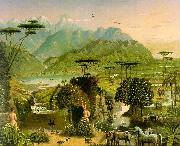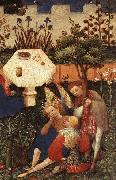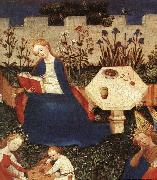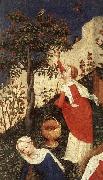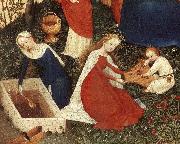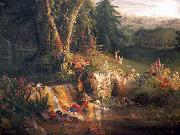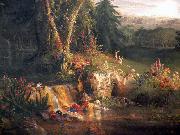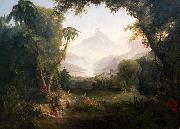Wholesale Oil Painting No Minimum |
|||||||||||
|
|
|||||||||||

|
|||||||||||
|
|
|
||||||||
Erastus Salisbury Field1805-1900 American painter. He studied with Samuel F. B. Morse in New York during the winter of 1824-5. On his return to the rural isolation of Leverett, MA, he painted his earliest known work, the portrait of his grandmother Elizabeth Billings Ashley (Springfield, MA, Mus. F.A.). His career as an itinerant portrait painter began in 1826, most of his commissions coming through a network of family associations in western Massachusetts and Connecticut. The portraits of 1836-40 are considered his best. From 1841 he lived mainly in New York, where he expanded his subject-matter to include landscapes and American history pictures. There he presumably studied photography, for on his return to Massachusetts he advertised himself as a daguerreotypist. His few portraits painted after 1841 are copied from his own photographs and lack the expressive characterization and decorative power of his earlier work. From 1865 to 1885 his paintings were based primarily on biblical and patriotic themes. The Historical Monument of the American Republic (1867-88; Springfield, MA, Mus. F.A.) stands alone in American folk art in size (2.82*3.89 m), scope and imaginative vision. Inspired by plans for a national celebration of the centennial of the USA in 1876, Field painted an architectural fantasy of eight towers linked by railway bridges and trains at the tops, with the history of the USA in low-relief sculpture on the exterior surfaces of the towers. Field added two more towers to the painting in 1888 and thereafter retired. |
||||||||
|
|
||||||||
The Garden of Eden
The Garden of Eden Painting ID:: 4020 |
1865 1865 |
|||||||
|
|
||||||||
|
|
||||||||
|
|
The Garden of Eden
The Garden of Eden Painting ID:: 63557 |
1410 Tempera on wood St?delsches Kunstinstitut, Frankfurt The other tree in the Garden is that of Knowledge, which is also the Tree of Death. It is embraced by the youthful St Sebastian, whose martyrdom (he was tied to a tree and killed by arrows) may be related to the crucifixion of Jesus. The figures sitting in front are easily recognizable by their attributes: the Archangel St Michael by the monkey-like monster cowering at his feet, who is the vanquished Satan himself; St George by his knightly clothes and by the corpse of the dragon, the embodiment of earthly wickedness.Artist:UNKNOWN MASTER, German Title: The Garden of Eden (detail) Painted in 1401-1450 , German - - painting : religious 1410 Tempera on wood St?delsches Kunstinstitut, Frankfurt The other tree in the Garden is that of Knowledge, which is also the Tree of Death. It is embraced by the youthful St Sebastian, whose martyrdom (he was tied to a tree and killed by arrows) may be related to the crucifixion of Jesus. The figures sitting in front are easily recognizable by their attributes: the Archangel St Michael by the monkey-like monster cowering at his feet, who is the vanquished Satan himself; St George by his knightly clothes and by the corpse of the dragon, the embodiment of earthly wickedness.Artist:UNKNOWN MASTER, German Title: The Garden of Eden (detail) Painted in 1401-1450 , German - - painting : religious |
||||||
|
|
||||||||
|
|
||||||||
|
|
The Garden of Eden
The Garden of Eden Painting ID:: 63558 |
1410 Tempera on wood St?delsches Kunstinstitut, Frankfurt Mary appears in her usual colours, blue and red. Her attributes are illustrated by the flowers richly carpeting the foreground (lilies and lilies of the valley = purity; rose = illumination; violets = modesty and humility) . These flowers, which were also used for medicinal purposes, frequently became connected with the person of the Madonna. In a fourteenth-century poem from the Netherlands, surviving in manuscript form, twelve different flowers refer to Mary, eight of which can be found in this painting.Artist:UNKNOWN MASTER, German Title: The Garden of Eden (detail) Painted in 1401-1450 , German - - painting : religious 1410 Tempera on wood St?delsches Kunstinstitut, Frankfurt Mary appears in her usual colours, blue and red. Her attributes are illustrated by the flowers richly carpeting the foreground (lilies and lilies of the valley = purity; rose = illumination; violets = modesty and humility) . These flowers, which were also used for medicinal purposes, frequently became connected with the person of the Madonna. In a fourteenth-century poem from the Netherlands, surviving in manuscript form, twelve different flowers refer to Mary, eight of which can be found in this painting.Artist:UNKNOWN MASTER, German Title: The Garden of Eden (detail) Painted in 1401-1450 , German - - painting : religious |
||||||
|
|
||||||||
|
|
||||||||
|
|
The Garden of Eden
The Garden of Eden Painting ID:: 63559 |
1410 Tempera on wood St?delsches Kunstinstitut, Frankfurt Into the picture of love and undisturbed idyll enters music as the Child Jesus, assisted by St Catherine of Alexandria, plucks on a psaltery. Beyond expressing harmony, music in this picture also refers to the divine nature of this human Jesus. The duality of his being is also intimated by a cherry tree - here substituting for a tree of life - with its twin trunk and bough, from which St Dorothy picks fruit.Artist:UNKNOWN MASTER, German Title: The Garden of Eden (detail) Painted in 1401-1450 , German - - painting : religious 1410 Tempera on wood St?delsches Kunstinstitut, Frankfurt Into the picture of love and undisturbed idyll enters music as the Child Jesus, assisted by St Catherine of Alexandria, plucks on a psaltery. Beyond expressing harmony, music in this picture also refers to the divine nature of this human Jesus. The duality of his being is also intimated by a cherry tree - here substituting for a tree of life - with its twin trunk and bough, from which St Dorothy picks fruit.Artist:UNKNOWN MASTER, German Title: The Garden of Eden (detail) Painted in 1401-1450 , German - - painting : religious |
||||||
|
|
||||||||
|
|
||||||||
|
|
The Garden of Eden
The Garden of Eden Painting ID:: 63560 |
1410 Tempera on wood St?delsches Kunstinstitut, Frankfurt The female figure wearing a white scarf and drawing from the water of life is St Barbara, whose humility and unshakable strong faith ties her closely to Mary.Artist:UNKNOWN MASTER, German Title: The Garden of Eden (detail) Painted in 1401-1450 , German - - painting : religious 1410 Tempera on wood St?delsches Kunstinstitut, Frankfurt The female figure wearing a white scarf and drawing from the water of life is St Barbara, whose humility and unshakable strong faith ties her closely to Mary.Artist:UNKNOWN MASTER, German Title: The Garden of Eden (detail) Painted in 1401-1450 , German - - painting : religious |
||||||
|
|
||||||||
Thomas Cole1801-1848 Thomas Cole Galleries Thomas Cole (February 1, 1801 - February 11, 1848) was a 19th century American artist. He is regarded as the founder of the Hudson River School, an American art movement that flourished in the mid-19th century. Cole's Hudson River School, as well as his own work, was known for its realistic and detailed portrayal of American landscape and wilderness, which feature themes of romanticism and naturalism. In New York he sold three paintings to George W. Bruen, who financed a summer trip to the Hudson Valley where he visited the Catskill Mountain House and painted the ruins of Fort Putnam. Returning to New York he displayed three landscapes in the window of a bookstore; according to the New York Evening Post, this garnered Cole the attention of John Trumbull, Asher B. Durand, and William Dunlap. Among the paintings was a landscape called "View of Fort Ticonderoga from Gelyna". Trumbull was especially impressed with the work of the young artist and sought him out, bought one of his paintings, and put him into contact with a number of his wealthy friends including Robert Gilmor of Baltimore and Daniel Wadsworth of Hartford, who became important patrons of the artist. Cole was primarily a painter of landscapes, but he also painted allegorical works. The most famous of these are the five-part series, The Course of Empire, now in the collection of the New York Historical Society and the four-part The Voyage of Life. There are two versions of the latter, one at the National Gallery in Washington, D.C., the other at the Munson-Williams-Proctor Arts Institute in Utica, New York. Cole influenced his artistic peers, especially Asher B. Durand and Frederic Edwin Church, who studied with Cole from 1844 to 1846. Cole spent the years 1829 to 1832 and 1841-1842 abroad, mainly in England and Italy; in Florence he lived with the sculptor Horatio Greenough. |
||||||||
|
|
||||||||
|
|
The Garden of Eden
The Garden of Eden Painting ID:: 82182 |
The Garden of Eden, 1828, Oil on canvas
Date 1828
cjr The Garden of Eden, 1828, Oil on canvas Date 1828 cjr |
||||||
|
|
||||||||
Thomas Cole1801-1848 Thomas Cole Galleries Thomas Cole (February 1, 1801 - February 11, 1848) was a 19th century American artist. He is regarded as the founder of the Hudson River School, an American art movement that flourished in the mid-19th century. Cole's Hudson River School, as well as his own work, was known for its realistic and detailed portrayal of American landscape and wilderness, which feature themes of romanticism and naturalism. In New York he sold three paintings to George W. Bruen, who financed a summer trip to the Hudson Valley where he visited the Catskill Mountain House and painted the ruins of Fort Putnam. Returning to New York he displayed three landscapes in the window of a bookstore; according to the New York Evening Post, this garnered Cole the attention of John Trumbull, Asher B. Durand, and William Dunlap. Among the paintings was a landscape called "View of Fort Ticonderoga from Gelyna". Trumbull was especially impressed with the work of the young artist and sought him out, bought one of his paintings, and put him into contact with a number of his wealthy friends including Robert Gilmor of Baltimore and Daniel Wadsworth of Hartford, who became important patrons of the artist. Cole was primarily a painter of landscapes, but he also painted allegorical works. The most famous of these are the five-part series, The Course of Empire, now in the collection of the New York Historical Society and the four-part The Voyage of Life. There are two versions of the latter, one at the National Gallery in Washington, D.C., the other at the Munson-Williams-Proctor Arts Institute in Utica, New York. Cole influenced his artistic peers, especially Asher B. Durand and Frederic Edwin Church, who studied with Cole from 1844 to 1846. Cole spent the years 1829 to 1832 and 1841-1842 abroad, mainly in England and Italy; in Florence he lived with the sculptor Horatio Greenough. |
||||||||
|
|
||||||||
|
|
The Garden of Eden
The Garden of Eden Painting ID:: 85832 |
1828, Oil on canvas
cyf 1828, Oil on canvas cyf |
||||||
|
|
||||||||
Thomas Cole1801-1848 Thomas Cole Galleries Thomas Cole (February 1, 1801 - February 11, 1848) was a 19th century American artist. He is regarded as the founder of the Hudson River School, an American art movement that flourished in the mid-19th century. Cole's Hudson River School, as well as his own work, was known for its realistic and detailed portrayal of American landscape and wilderness, which feature themes of romanticism and naturalism. In New York he sold three paintings to George W. Bruen, who financed a summer trip to the Hudson Valley where he visited the Catskill Mountain House and painted the ruins of Fort Putnam. Returning to New York he displayed three landscapes in the window of a bookstore; according to the New York Evening Post, this garnered Cole the attention of John Trumbull, Asher B. Durand, and William Dunlap. Among the paintings was a landscape called "View of Fort Ticonderoga from Gelyna". Trumbull was especially impressed with the work of the young artist and sought him out, bought one of his paintings, and put him into contact with a number of his wealthy friends including Robert Gilmor of Baltimore and Daniel Wadsworth of Hartford, who became important patrons of the artist. Cole was primarily a painter of landscapes, but he also painted allegorical works. The most famous of these are the five-part series, The Course of Empire, now in the collection of the New York Historical Society and the four-part The Voyage of Life. There are two versions of the latter, one at the National Gallery in Washington, D.C., the other at the Munson-Williams-Proctor Arts Institute in Utica, New York. Cole influenced his artistic peers, especially Asher B. Durand and Frederic Edwin Church, who studied with Cole from 1844 to 1846. Cole spent the years 1829 to 1832 and 1841-1842 abroad, mainly in England and Italy; in Florence he lived with the sculptor Horatio Greenough. |
||||||||
|
|
||||||||
|
|
The Garden of Eden
The Garden of Eden Painting ID:: 86501 |
1828, Oil on canvas
cyf 1828, Oil on canvas cyf |
||||||
|
|
||||||||
|
Thomas Cole 1801-1848 Thomas Cole Galleries Thomas Cole (February 1, 1801 - February 11, 1848) was a 19th century American artist. He is regarded as the founder of the Hudson River School, an American art movement that flourished in the mid-19th century. Cole's Hudson River School, as well as his own work, was known for its realistic and detailed portrayal of American landscape and wilderness, which feature themes of romanticism and naturalism. In New York he sold three paintings to George W. Bruen, who financed a summer trip to the Hudson Valley where he visited the Catskill Mountain House and painted the ruins of Fort Putnam. Returning to New York he displayed three landscapes in the window of a bookstore; according to the New York Evening Post, this garnered Cole the attention of John Trumbull, Asher B. Durand, and William Dunlap. Among the paintings was a landscape called "View of Fort Ticonderoga from Gelyna". Trumbull was especially impressed with the work of the young artist and sought him out, bought one of his paintings, and put him into contact with a number of his wealthy friends including Robert Gilmor of Baltimore and Daniel Wadsworth of Hartford, who became important patrons of the artist. Cole was primarily a painter of landscapes, but he also painted allegorical works. The most famous of these are the five-part series, The Course of Empire, now in the collection of the New York Historical Society and the four-part The Voyage of Life. There are two versions of the latter, one at the National Gallery in Washington, D.C., the other at the Munson-Williams-Proctor Arts Institute in Utica, New York. Cole influenced his artistic peers, especially Asher B. Durand and Frederic Edwin Church, who studied with Cole from 1844 to 1846. Cole spent the years 1829 to 1832 and 1841-1842 abroad, mainly in England and Italy; in Florence he lived with the sculptor Horatio Greenough. The Garden of Eden 1828, Oil on canvas cyf |
||||||||
|
|
||||||||
|
Prev Next
|
||||||||
|
|
||||||||
|
Related Paintings to Thomas Cole :. |
||||||||
|
|
||||||||
|
CONTACT US |
